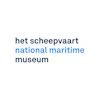
24. Oost 2, Navigational instruments
Anyone who sails the world’s oceans needs not only a seaworthy ship but also appropriate techniques for determining their course and position at sea, for measuring the speed of the ship and the depth of the water. Nowadays these measurements are carried out on ships using electronic equipment and satellite technology. This display shows some of the old navigational instruments that used to be crucially important for sailors, helping them with answers to the four key questions: Where am I? Where do I need to go? How fast am I moving? And how deep is the water? The most widely known navigational instrument is the compass. A number of interesting examples of these can be seen halfway through the exhibition, including a fine hanging compass that has to be read from underneath. The collection of navigational instruments at the National Maritime Museum is one of the most important in the world in terms of its size and the time period covered. These objects give us an excellent picture of the development of navigational knowledge, the craftsmanship of the instrument makers and the beauty of their products.


The National Maritime Museum
Het Scheepvaartmuseum (The National Maritime Museum) shows the strong connection between the maritime world and society as a whole, and more specifically the impact of this on the lives of many individuals. The collection of The National Maritime Museum is one of the largest and most notable maritime collections in the world with approximately 400,000 objects, including paintings, models of ships, navigation instruments, and maps of the world. Discover 500 years of Dutch Maritime history as well as its strong links to today’s society and the society of the future.
- Kattenburgerplein 1
- Amsterdam Netherlands
- (020) 52 32 222
- www.hetscheepvaartmuseum.nl
